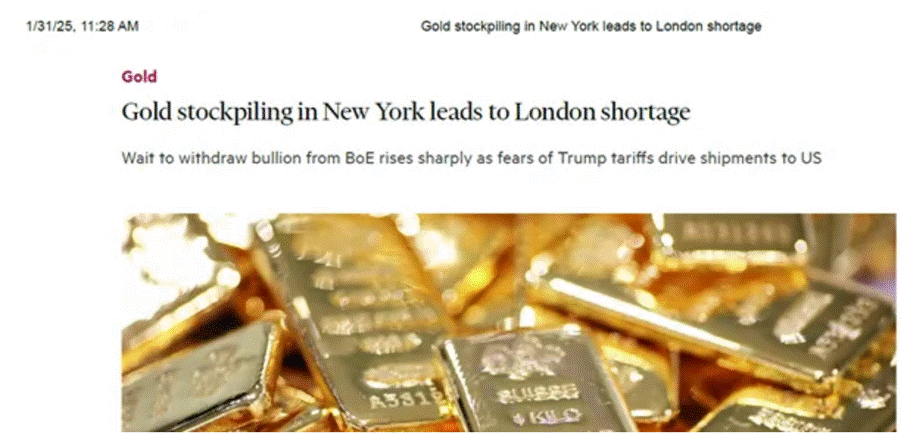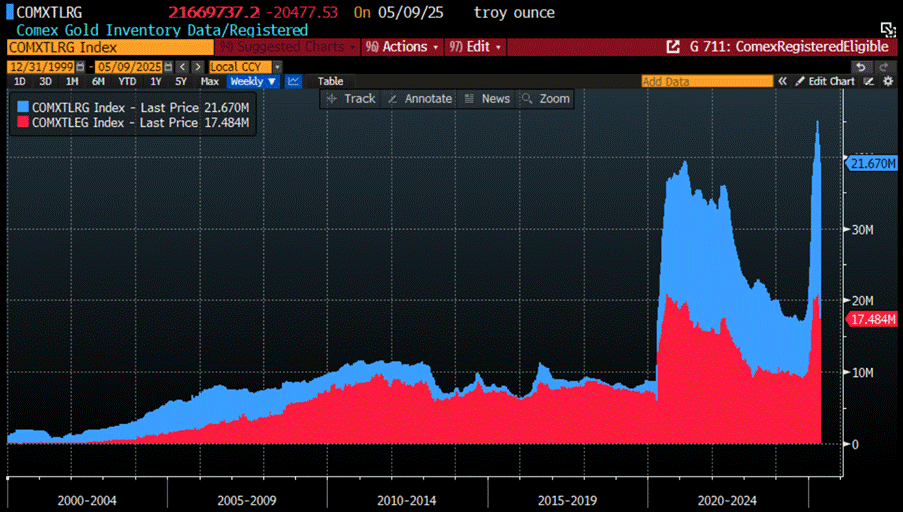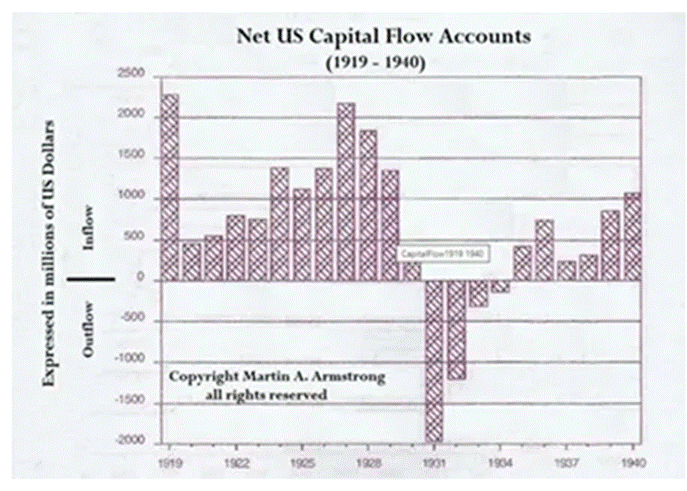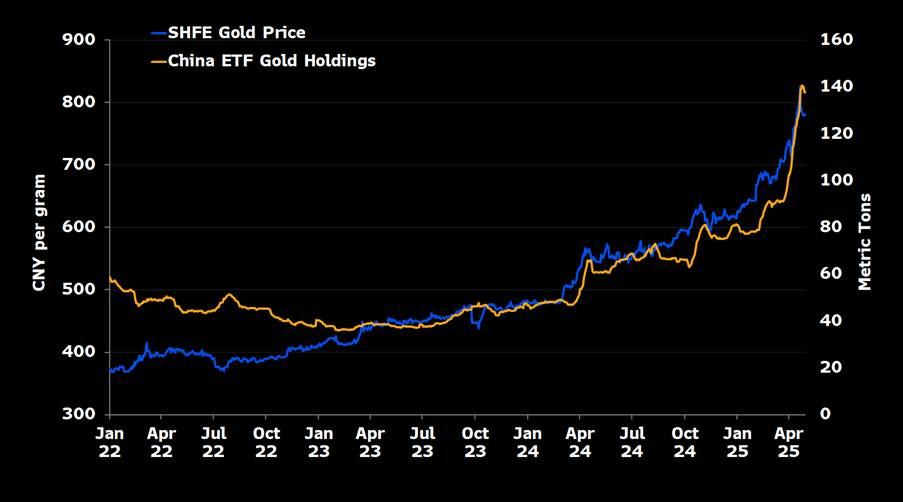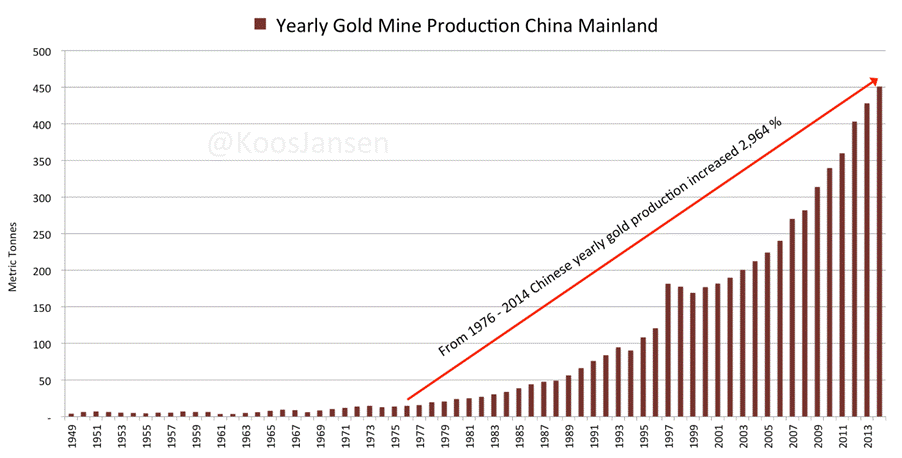The COMEX Show...
The Truman Show’s roots trace back to screenwriter Andrew Niccol’s dark idea, The Malcolm Show—a dystopian thriller about a guy unknowingly trapped in a corporate-sponsored fishbowl. Enter director Peter Weir, who swapped the doom-and-gloom for satire and cast Jim Carrey in a rare "no rubber face" role. By the time it hit theatres in 1998, The Truman Show was serving up Orwell-lite with a side of media critique, long before reality TV and Instagram influencers made self-surveillance trendy. The film warned us: if someone controls the camera, they probably control the truth.
Fast-forward to today’s financial markets are a dystopian version of the Truman Show, where investors play Truman in suits. Central banks script the plot, financial media handles PR, and algos keep the extras moving. Gold, the quiet rebel of the story, is inevitably soaring in a world of debt, war, and inflation. But the reality is that derivatives and interventions keep its price on a leash. The smart money? It’s pulling a Truman—looking for the exit, ignoring the set, and realizing gold isn’t just another asset, it’s a crack in the façade.
Savvy investors know it's not just the economy that moves in cycles—wars do too. And behind both? Capital flows, quietly steering the ship of history. From ancient trade caravans to digital wire transfers, money has always chased opportunity (and occasionally, fantasy). Cicero warned that tremors in Asia could shake Rome. Aristotle grumbled about money-making long before Marx made it fashionable. Fast forward: colonial powers looted wealth, industrialization shifted capital Westward, and Bretton Woods turned money into a geopolitical chess piece.
Speculative bubbles? Nothing new. The South Sea and Mississippi Bubbles of the early 1700s were fueled by cross-border FOMO, as investors from across Europe piled into pipe dreams of gold, trade, and Louisiana swamps. Spoiler alert: it didn’t end well. Fortunes vanished faster than John Law’s credibility. Then came the Panic of 1896—silver crashed, railroads tanked, and American banks folded like cheap tents. British capital swooped in, buying up distressed assets and reminding everyone that when one market sneezes, another sees a buying opportunity.
Now? We’re seeing déjà vu with a twist. Despite mainstream spin, the biggest capital flow of 2025 isn’t tech stocks or politically driven crypto scams—it’s gold, which has been quietly fleeing London and Zurich vaults for Comex’s Manhattan fortress. The excuse? Tariffs. The reality? Those in the know suspect capital controls are coming to Europe. Why? Because the war cycle is heating up on the continent’s eastern flank, and history shows what happens next: controls, confiscations, and a rush for the exits. Gold, once again, is the canary in the vault.
https://www.ft.com/content/86a5fafd-603e-4ee1-9620-39b5f4465f53
The COMEX (run by CME Group) is basically Wall Street’s version of a gold casino—where most of the shiny stuff is traded on paper, not in hand. It’s a place where two parties—one betting prices will rise (the long), the other betting they’ll fall (the short)—duel it out in the futures market, with the Comex acting as the referee.
Most traders never touch real metal; they just roll contracts from month to month like it's a game of financial hot potato. But if someone really wants delivery (read: prefers bars to spreadsheets), they have to pony up the full value before the “First Position Date.” That’s when the short has to cough up actual gold.
Futures come with leverage too—why buy $180K of gold when you can just throw down 15% as margin and pretend you own it? But if you post the full amount and don’t roll, you’re saying, “I want the bars.” Once delivered, those bars usually stay in the Comex vault, stamped as “Registered”—basically an “Eligible” bar with a backstage pass (a warrant) saying it’s good to go.
Bottom line: it’s all fun and leverage until someone asks for delivery. Then the real game begins.
Since the U.S. election on November 5th, gold traders and financial institutions have quietly shifted around 24 million troy ounces (roughly 746 tons) into Comex vaults—clearly, someone’s not feeling great about what’s ahead. With total gold stockpiles in Comex storage now hitting 39.15 million ounces, that’s almost the highest level in 35 years—beating even the pandemic panic of May 2020, when everyone suddenly remembered gold doesn’t default or need a bailout.
Comex Gold Inventory data & Monthly Change
Tracking delivery data is like peeking behind the curtain of the paper gold game. When investors actually take delivery, it’s not for fun—they’ve paid the full contract value and signed up for storage costs, so chances are they want the real deal. While there are many reasons to take delivery, a surge in these requests could signal a looming “bank run” on gold—only instead of dollar bills, it’s bars of metal.
Since 2019—and especially post-2020—more players have been saying, “I’ll take the bars, thanks.” If that trend keeps up (or picks up speed), things could get interesting fast. That’s because, eventually, someone has to cough up real metal—not just IOUs—putting serious pressure on supply and potentially sending gold and silver prices much higher.
Source: COMEX.
Since the U.S. election, the COMEX has been busier than a Black Friday sale—with gold deliveries hitting levels not seen before. This spike has been driven by a juicy arbitrage opportunity between spot and futures prices, which traders were more than happy to exploit. While things have cooled a bit, the market’s still behaving like it had one too many espressos. April stood out in particular—racking up 64,514 contracts delivered, the second-highest on record. That’s about $21.3 billion worth of gold handed over. So yes, someone out there really wants their metal.
Spread in $ between Futures & Spot Price.
Switching gears to Comex physical inventories…Comex stores gold in two main categories: Eligible and Registered. Eligible means the gold meets exchange standards and sits in a Comex-approved vault but can’t be delivered until it’s tagged with a warrant. Registered gold, on the other hand, has that warrant—it’s ready to go for anyone demanding physical delivery. Pledged gold is just Registered gold that's being used as collateral, so it is grouped under Registered for simplicity.
Interestingly, inventory levels have dropped since April—possibly because someone opted to skip the usual cash settlement and actually walked off with the metal. Unlike 2019, when Registered gold all but vanished and vaults were stuffed with “Eligible-but-hands-off” bars, we’re now seeing a solid stock of Registered gold. That’s a big deal—it means more gold is ready for delivery, but it also raises the question: who’s prepping for something and quietly calling in the shiny stuff?
Comex Registered Gold Inventory (blue histogram); Comex Eligible Gold Inventory (red histogram).
Unlike ‘paper’ gold—which is basically financial cosplay with no metal involved—COMEX gold futures can be settled in real, shiny bars. But here’s the kicker: in 2018, only 1.6 million ounces (a mere 51 tonnes) actually changed hands. That means 99.98% of traders said, “Nah, I’m good” when it came time to take delivery. As for where the real stuff is piling up? Just three vaults—Brink's, HSBC, and JPMorgan—are hoarding more than 80% of all COMEX gold. And JPMorgan? They’re not just in the lead—they’re basically the Fort Knox of Wall Street. Seems like when it comes to physical gold, the big players are making sure they’ve got their hands on the goods... just in case the music stops.
Interestingly, gold has been partying hard since February—but the usual crowd of COMEX speculators didn’t get the invite. Prices have surged without much action in speculative futures, meaning this rally has legs... but no cheerleaders.
Implied holdings actually peaked in early February and have dropped since, even as gold keeps printing higher highs and lows. With just 567 tons in non-commercial net holdings—the lowest since March 15, 2024, when gold was over $1,000 cheaper—this might just be the most hated gold rally in COMEX history. Spectators are sulking while gold’s doing a solo victory lap.
The same goes for U.S. retail investors—still too comfy (or lazy) to hold the real stuff and instead clinging to gold ETFs like they’re the real deal. Spoiler: they’re not. These paper proxies are about as anti-fragile as a sandcastle in a hurricane.
Gold ETFs only started seeing net inflows in late February 2025, and with 88.9 million ounces under management, they're just now crawling back to where they were in September 2023—when gold was still under $2,000 an ounce. For context, ETF holdings peaked back in Q3 2020, and we’re still 22 million ounces shy of that high. Translation? This gold party isn’t crowded yet. There’s plenty of room before we hit euphoria.
The Jubilee year isn’t even halfway through, and it’s been anything but boring—from trade wars to failed truces in Eastern Europe and the Middle East. Geopolitical risks are quickly becoming a major driver for gold prices in the years ahead. While these events are typically short-lived, if they start to rattle the financial markets, their impact can linger. The Geopolitical Risk (GPR) Index began climbing as the U.S. election approached, with candidates promising to raise tariffs, especially against China, threatening global growth. According to the World Gold Council, every 100-point rise in the GPR Index tends to boost gold by 2.5%. Experts like Dario Caldara and Matteo Iacoviello track these risks using automated searches across major newspapers covering global tensions.
Looking at gold’s price movements over the past 20 years, it’s clear: risk events might be temporary, but if they mess with financial markets, gold rallies. On average, these events lead to a 10% price jump over five weeks, and the rally often takes twice as long to subside. For instance, during the 2008 financial crisis, gold rose 26.5% in 12 weeks, and it took over a year for the price to settle. The same pattern followed in January 2016, and Russia’s invasion of Ukraine saw gold jump 11% in 11 weeks before normalizing.
So, it’s no surprise that as geopolitical risk rises, so does the price of gold. After all, anyone with a clue knows that when war is on the horizon, gold is the only truly anti-fragile asset with zero counterparty risk.
Gold Price in USD (blue line); Geopolitical Risk Index (GPR Index) (red line).
In short, smart money is moving gold from London and Zurich to New York, likely anticipating capital controls and Europe’s escalating war drama. Investors know the drill—history’s shown that in times of war and financial chaos, gold heads to safer spots (like the U.S.). Europe’s facing political instability and rising tariffs, making a sovereign debt crisis a real possibility. And let’s be honest, no one in Canary Wharf or Wall Street is telling their clients that capital controls in the Eurozone could happen sooner than we think. Just look at history: wars always make capital flee to safer places, opening up fresh opportunities.
While the West is still caught up in the COMEX Show, the real story is that China has become a far more significant player in the gold market. With property prices declining and the currency losing ground, the Chinese are getting smarter with their gold buys, pushing more strategic purchasing. This shift is evident in strong fund inflows from major ETF providers. March’s gold rally saw these inflows surge, mirroring a similar trend we’re likely to see in the US when retail and institutional investors start to realize that only gold will help them preserve their wealtth in the inevitable ‘Trump Stagflation’. The writing’s on the wall—China’s buying power is shifting the gold game.
If you ever doubted how seriously China takes gold, consider this: the People's Liberation Army (yes, the actual military) has had its own gold-hunting squad since 1979. Because clearly, tanks and camouflage are the natural tools for geology. This elite bling battalion has dug up over 1,800 tons of gold, helping China snag the title of world’s top gold producer—not by chance, but by military-grade commitment. And it’s not just about digging; the PLA also plays bodyguard, escorting gold convoys through treacherous terrain like they’re protecting a nuclear football. Nothing screams "strategic asset" like armored vehicles hauling gold through dust storms. Clearly, in China, gold isn’t just an anti fragile asset—it’s practically a matter of national defense.
https://www.bullionstar.com/blogs/koos-jansen/chinas-gold-army/
Like Truman Burbank trapped in a shiny illusion, millions of investors watch COMEX each day, thinking they're seeing the real story of gold prices. Spoiler alert: they're not. Behind the glittery paper façade lies a stage managed by algorithms and hype, with physical gold playing the understudy nobody mentions. But savvy investors are starting to walk off set—right into the arms of China, where the real bullion action is quietly stacking up. While Wall Street yells about chart patterns, Chinese buyers are hoarding bars like it's a national sport. April saw gold prices hit record highs (again), and despite some profit-taking, the message is clear: demand for physical is alive, well, and definitely not coming from your local ETF. So enjoy The COMEX Show—where the price is fake, the drama is real, and the truth is sealed in vaults. The only question left: got gold?
As the war cycle is about to accelerate again, savvy investors understand that to preserve and grow their wealth, they must adapt to the business cycle rather than attempt to change it. They should focus on Return OF Capital rather than Return ON Capital, by owning real assets like physical gold and silver, the only antifragile assets with no counterparty risk. They also must hold other commodities to weather the storm unleashed by the ‘Commodity Leviathan.’
Read more and discover how to trade it here: https://themacrobutler.substack.com/p/the-comex-show
If this research has inspired you to invest in gold and silver, consider GoldSilver.com to buy your physical gold:
https://goldsilver.com/?aff=TMB

Disclaimer
The content provided in this newsletter is for general information purposes only. No information, materials, services, and other content provided in this post constitute solicitation, recommendation, endorsement or any financial, investment, or other advice.
Seek independent professional consultation in the form of legal, financial, and fiscal advice before making any investment decisions.
Always perform your own due diligence.



